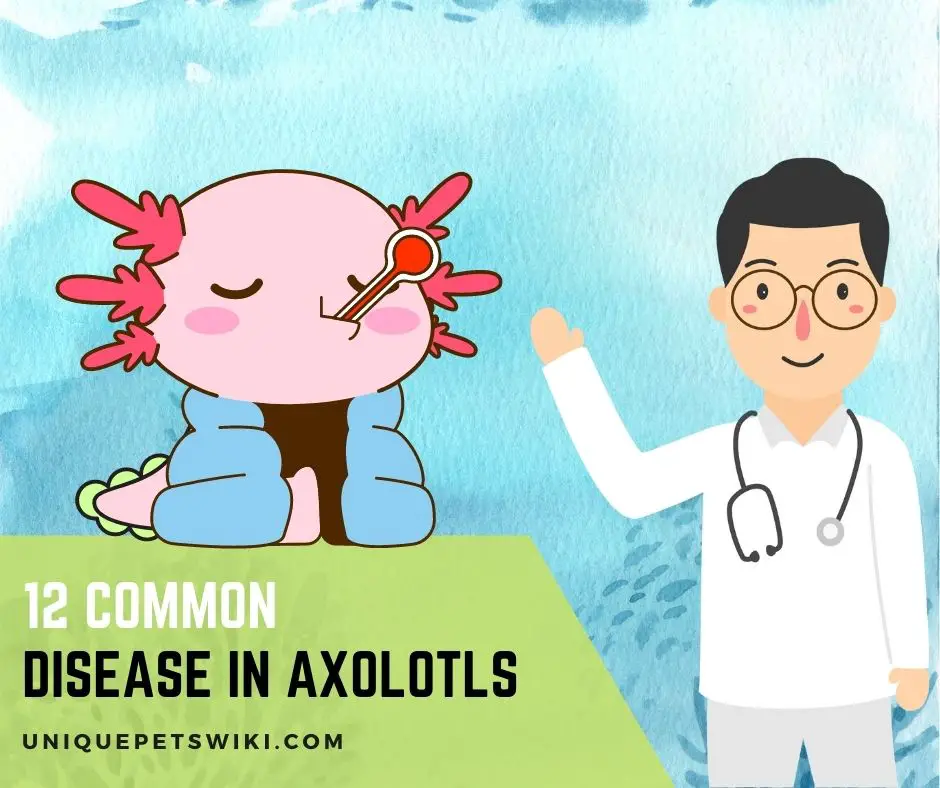Axolotls are quite hardy pets and don’t get sick if you can house them in an ideal environment. Furthermore, they have a regeneration capability to regrow their limbs and regenerate organ parts.
Like other aquatic animals, axolotls are not immune to diseases. Axolotls can develop health problems like lack of appetite, bacterial infections, fungus, curled gills, and lots more.
However, the main reason for health problems in axolotl is usually their aquarium environment.
As a responsible axolotl owner, you need to research the common disease in axolotls, the causes, and how you can treat them.
This article got you covered as it describes everything you need to know about common diseases of axolotls.
Contents
How Do You Know If Your Axolotl Has Disease?
The best way to determine if your axolotl is sick is to look for signs of sickness. A healthy axolotl is usually active at night when there is less light. Some of the signs that indicate that an axolotl is sick are stated below:
- Loss of appetite
- Deterioration of the gills
- Jaundice
- Back deformities
- Your axolotl is floating frequently
- Bulging of the eyes
- Inability to poop
- Redness all over their body
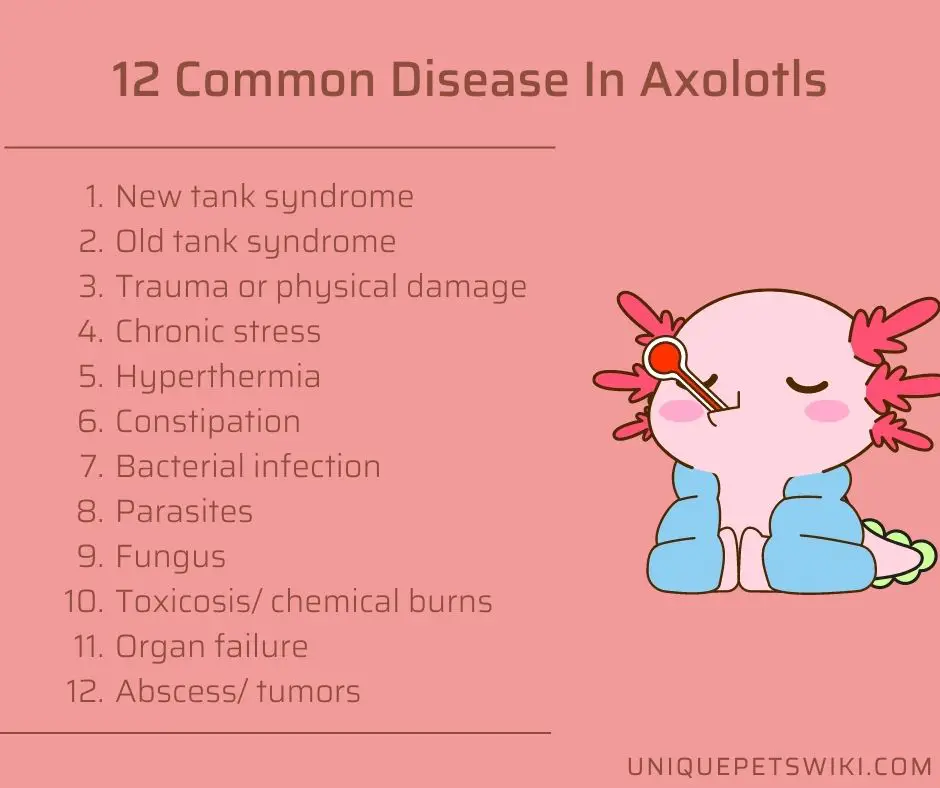
12 Common Disease In Axolotls
We have highlighted 12 common diseases that axolotls can get, the accompanying signs, the reason for the health problem, and how you can treat and prevent them.
| Disease | Typical Symptom | Dangerous Level | Treatment Possibility |
| New Tank Syndrome | Loss of appetiteShrinking gill filaments | Medium | Yes |
| Old Tank Syndrome | Bulging eyesCloudy eyes | Medium | Yes |
| Trauma/injuries | An axolotl missing a leg, a piece of its gills, the end of the tail, and a piece of its lip | Medium | Yes |
| Chronic Stress | Gills bent forwardRefuses to eat | Medium | Yes |
| Hyperthermia | InappetanceAscites to uncontrollable floating | High | Yes |
| Constipation | Inability to poopBloatingFloating | High | Yes |
| Bacterial Infection | Fluffy gray or white patches | High | Yes |
| Parasites Infection | Remain skinny, Emaciation | Medium | Yes |
| Fungus Infection | Fluffy white cottony tufts on the axolotls gills, limbs, head, or body | Medium | Yes |
| Toxicosis/Chemical Burns | Redness all over its body, and the gill filaments are like burning | High | Yes |
| Organ failure | Bloat and sometimes develop bruised looking patches. Fluid build-up (edema and ascites) | High | No |
| Abscess/Tumors | Bumps and lumps on the skin | Low | Yes |
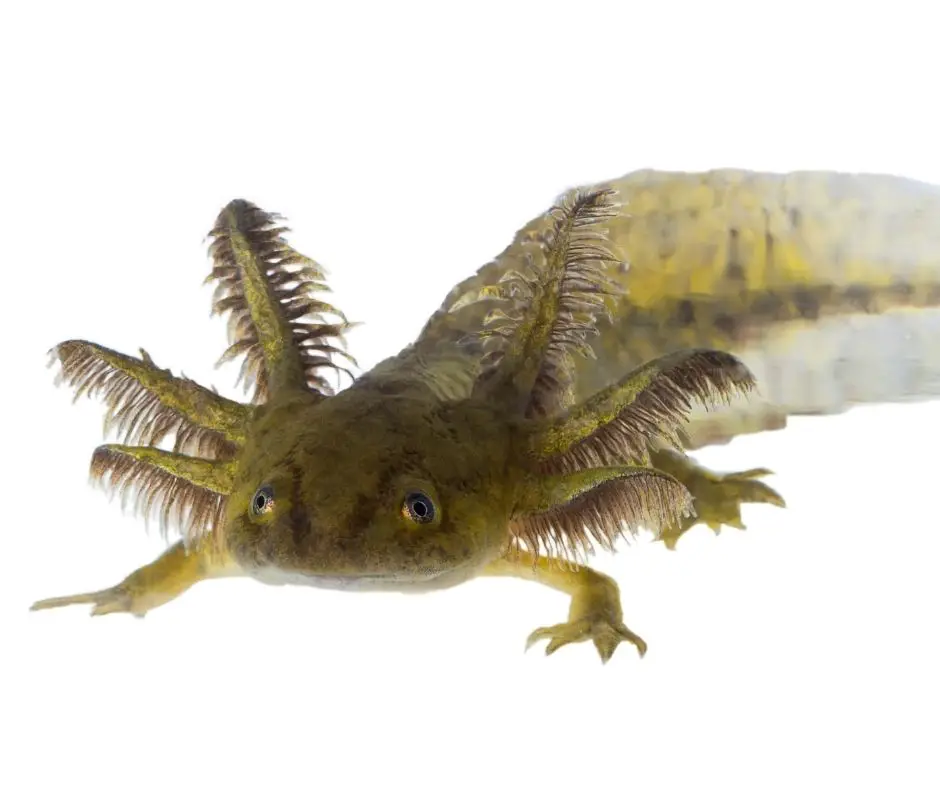
New Tank Syndrome
New tank syndrome is a health problem that occurs when you set up an aquarium with clean water without enough biofilter to convert the ammonia to nitrate
Adding axolotl to this environment can lead to the buildup of ammonia and nitrite, causing health problems to your axolotls.
New tank syndrome can occur if
- You do not leave enough time for nitrifying bacteria in the biofilter to establish during cycling.
- There is the damage to the biofilter microflora
- Overfeeding of your axolotls.
- Overcrowding your axolotls in a tank.
Some of the common signs of a new tank syndrome are
- Loss of appetite
- Shrinking gill filaments
Once you notice this health problem, the first thing to do is to determine its underlying cause. You can then treat it by doing multiple water changes and adding nitrifying bacteria to the biofilter.
You can also prevent this from happening by
- Ensuring your water is appropriately cycled before adding your axolotls
- Avoid overfeeding your axolotl.
- Not overcrowding axolotls in a tank.
- Putting an efficient filter in the tank.
API QUICK START Freshwater and Saltwater Aquarium Nitrifying Bacteria
- Contains one (1) API QUICK START Freshwater and Saltwater Aquarium Nitrifying Bacteria 16-Ounce Bottle
- Allows instant addition of fish when starting a new aquarium
- Reduces compounds harmful to fish when used routinely
- Helps prevent fish loss in freshwater and saltwater aquariums
- Use when starting a new aquarium, when adding new fish and when changing water and filter media
Last update on 2022-12-29 / Affiliate links / Images from Amazon Product Advertising API
Old Tank Syndrome
Old tank syndrome is a condition where the water quality in your axolotl’s tank has degraded over time, leading to health problems and sudden death of axolotls.
Old tank syndrome causes a pH crash, leading to the buildup of nitrite in the tank.
Poor maintenance is the main cause of old tank syndrome in an axolotl tank.
Therefore, you can experience old tank syndrome in the tank if you don’t do water changes regularly or the filtration mechanism in the tank is clogged up or not working.
Some of the signs that indicate old tank syndrome in an axolotl tank are:
- Your axolotl has bulging or cloudy eyes
- The sudden death of your new axolotl introduced to the tank.
- Algae overgrowth
- The water quality is not at an ideal level.
Treatment of old tank syndrome involves doing 10-15% water changes daily until the water parameters are back to normal.
You will then need to monitor the ammonia and pH level in the water daily. If you notice a rapid increase in the ammonia level, you can skip changing the water for days and add filters to remove the ammonia.
Once the water parameter is at the ideal level, you can clean or change the filter media to help ensure it works properly. However, you can prevent old tank syndrome by:
- Maintaining the filter in the tank
- Doing a regular water change
- Testing the water regularly
Trauma or Physical Damage
Generally, axolotls have delicate skin and can experience traumatic injuries if handled roughly. However, axolotls have the regenerative ability and can regrow most of their body parts if injured.
Axolotls can get cuts or injuries on their body during a fight with their mate. They can also get injured if sharp objects are in their tank or if you handle them roughly.
It can take from a couple of weeks to several months before your axolotl heals completely based on your axolotl age, genetics, and other factors.
However, it is recommended that you treat the site of injuries on your axolotl to help prevent bacterial or fungal infections.
You should change their water frequently to help aid their healing rate. You can also add Indian almond leaves to the tank water as it has antibacterial properties.
The leaves can turn the water slightly yellow-brown, but it is safe for your axolotls.
You will also need to check the water parameter of the tank regularly to help ensure the water parameters in the tank are at a healthy level.
Premium Indian Almond Leave. Aquarium Decorations Size 6-9″
- 🍀 SUPERB FOR HEALTH OF YOUR BETTA FISH AND SHRIMP - Betta leaf rich in Tannin. it helping the betta fish and shrimp health to be noticeably better. And Enhances the natural color of to them.
- 🍀 BEST WAY TO CREATE A TROPICAL RAINFOREST ENVIRONMENT FOR THEM. - Catappa leaves help to adjust the water to have the pH value. And helps to add minerals as food sources. Make them feel like living in their natural environment. and vitality in tropical fish. They love it!.
- 🍀 SUCCESSFUL BREEDING GOOD SPAWNING AND BOOSTS HEALTH. - Stimulates the growth of Betta fish and shrimp. It helps reduce the stress of the Spawning season of breeders. just you only placed this magic leaf into the tank.
- 🍀 FROM NATURE TO YOUR BETTA FISH & SHRIMPS - 100% Natural Premium Dried Indian Almond Leaves, Mixes size 6-9 inch . Pack of 50g (about 20+ leaves). We picked up all the leaves to go through the meticulous process. By Washing!, Boiling!, and Drying!. And packing the leaves into the sealed zip bags well clean and safe. Convenient to use and keep for a long time. And they will be surprised by the fragrance of it.
- 🍀 EASY TO USE - Just drop a few leaves into your tank. Betta will start nibbling on the leaves, using them for cover, or may even lay eggs on the leaves. Or can cut to small a few pieces about 4 × 4 cm. for convenience and beauty in your aquarium. And discard the leaf after 1 week and replace it with a new leaf. And you will be surprised at their better health.
Last update on 2022-12-29 / Affiliate links / Images from Amazon Product Advertising API
Chronic Stress
Although stress is not a disease, chronic stress is a disease in axolotls. There are several things that can cause chronic stress in axolotls. However, the main cause of chronic stress in axolotl is the bad water parameter.
Axolotls can easily become stressed if the water in their tank goes about 15-23oC or there is a buildup of ammonia and nitrite in the tank.
Overcrowding your axolotl tank is another cause of stress in axolotls, especially if the axolotls are aggressive towards each other.
Water current is another cause of stress in axolotls. Keeping axolotls in a tank with a strong water current can stress out your axolotls. Axolotls don’t like bright lights, and keeping them in this condition will also stress out your axolotls.
Some of the signs that an axolotl is stressed are:
- Lack of appetite
Your axolotl gills bent forward - Axolotls float frequently.
Treating chronic stress in axolotl is quite easy if you can determine the cause. You can treat bad water quality by maintaining the tank regularly and using a filter.
You can treat stress caused by water current by using a filter that creates a gentle water flow.
Stress caused by overcrowding can be solved by housing your axolotls alone or housing them in a very big tank. Stress caused by bright light can be treated by providing several hiding areas for your axolotls to hide.
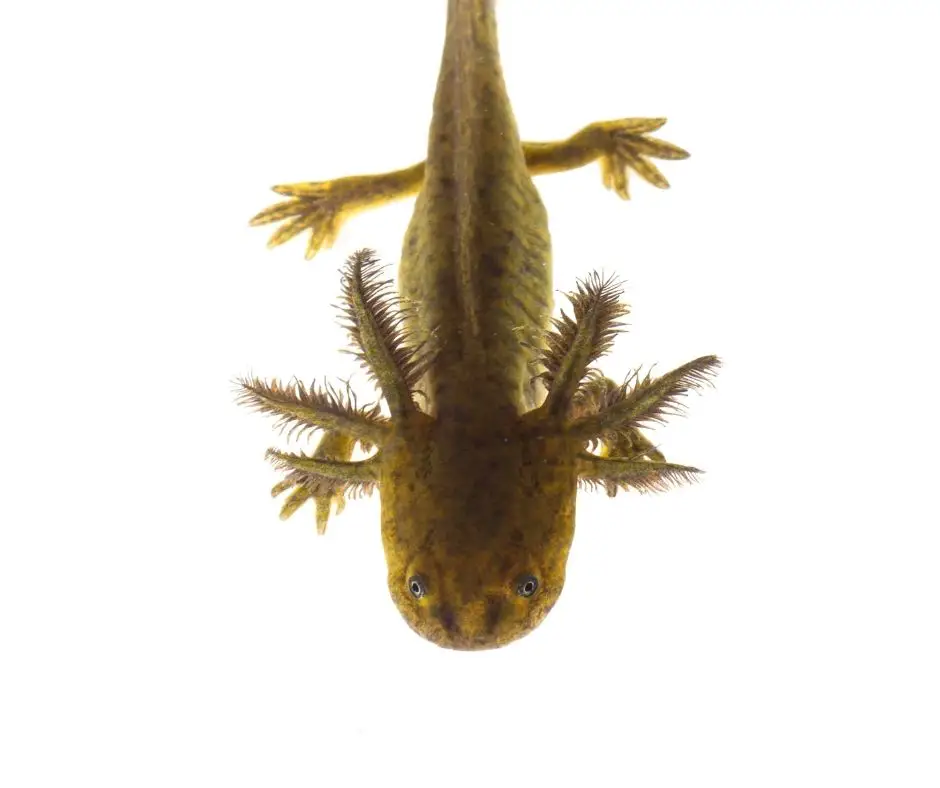
Hyperthermia
Hyperthermia is the opposite of hypothermia, and it is a condition where axolotls are exposed to prolonged hot temperatures, making them overheated. Generally, axolotls enjoy colder temperatures to stay healthy and active.
However, exposing them to high temperatures can be quite problematic as there will be a decrease in the oxygen in their tank and an increase in bacteria, leading to infections. Some of the symptoms of hyperthermia in axolotls are:
- Your axolotl floats uncontrollably
- Loss of appetite
- The buildup of fluid in their abdomen.
You can treat hyperthermia in axolotl by reducing the temperature in the tank, and you can do this by using a frozen water bottle to reduce the water temperature.
You can also invest in a water chiller to maintain the cool temperature in the enclosure.
For quick relief, you can put your axolotl in a dish and fridge it. It is also recommended to try out antibiotic therapy to help prevent secondary bacterial infections.
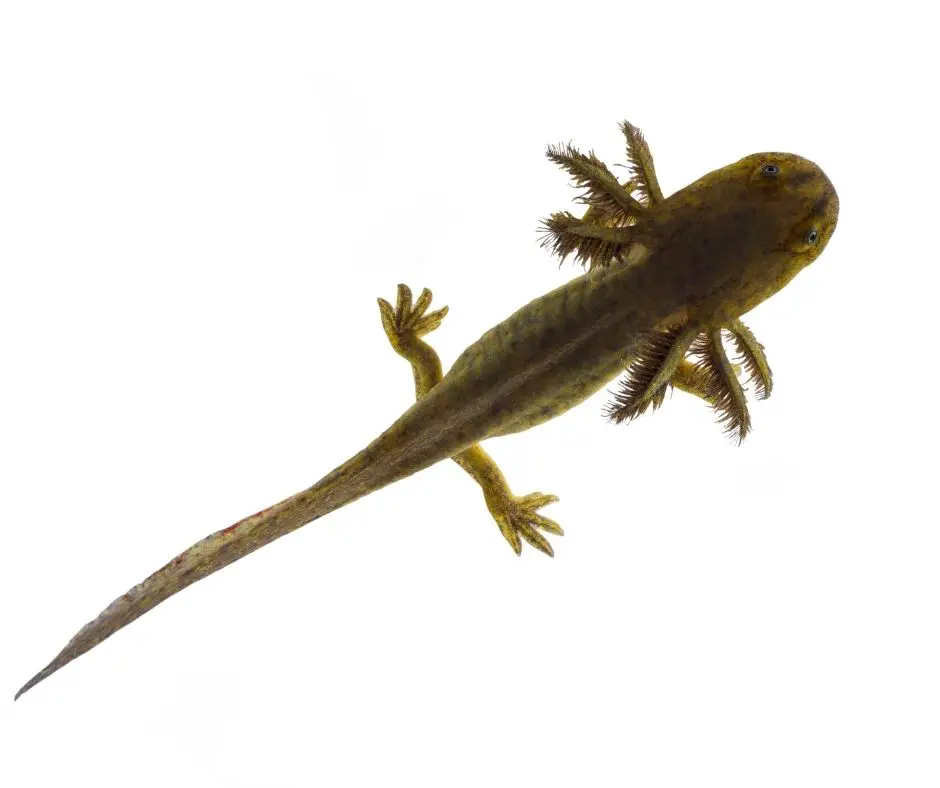
Constipation
Constipation is a health condition that can affect axolotls. Axolotls can develop this health problem if they ingest food or things of large size, which then blocks their intestine. Constipation in axolotl can lead to death if not detected quickly.
The two main causes of constipation in axolotl are
- Impaction
- Overfeeding.
Impaction
Impaction, also known as intestinal blockage, usually occurs if axolotls accidentally eat something they cannot digest easily. The blockage can be caused by rocks, chitin, tank décor, or anything your axolotl can swallow.
Some of the common signs that you can be on the lookout for if you have a constipated axolotl due to impaction are:
- Your axolotl is bloated
- Axolotl is passing little or no stool
- Lack of appetite
You can treat impaction in axolotl by fridging your axolotl to aid your axolotl passing out the ingested material.
However, your axolotl may require surgery if this method does not work. You can prevent impaction by removing indigestible items from their tank.
For instance, you should avoid using small gravel in the young axolotl tank. Another thing is only to use tank decorations that are durable and larger than your axolotl’s head.
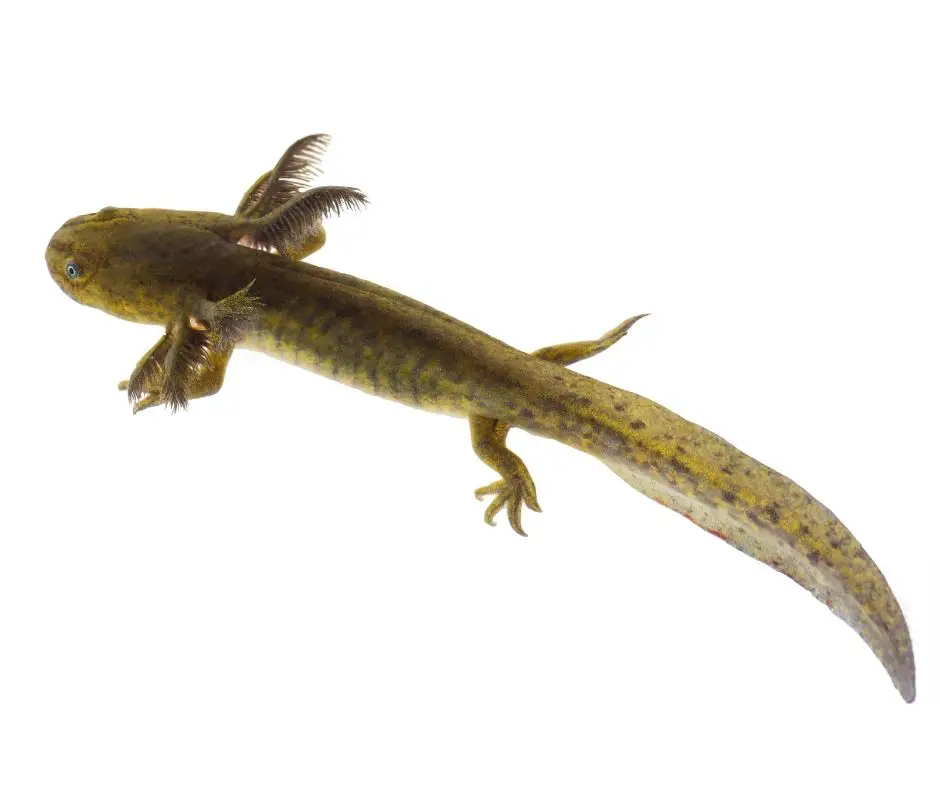
Overfeeding
Another common reason for constipation in axolotl is overfeeding. Your axolotl can get constipated if you feed them more than they can easily digest.
For instance, adult axolotls have a slower digestion rate, and feeding them very often can lead to overfeeding.
Some of the symptoms of overfeeding in axolotls are
- Your axolotl has a swollen belly (bloated).
- Your axolotl floats uncontrollably.
Your axolotl poops frequently.
If your axolotl is constipated due to overfeeding, the first thing to do is to stop feeding them for a few days. You can then resume feeding at a reduced rate if your axolotl continues passing waste afterward.
However, you may need to fridge your axolotl if they are not passing waste after you stop feeding them.
Some of the ways that you can prevent overfeeding your axolotls are:
- Only feed your axolotls what they can eat in one to three minutes.
- Ensure the water quality is at an optimal rate to keep your axolotl comfortable.
- Try to create a feeding schedule and quantity based on axolotls and how they respond to their diet.
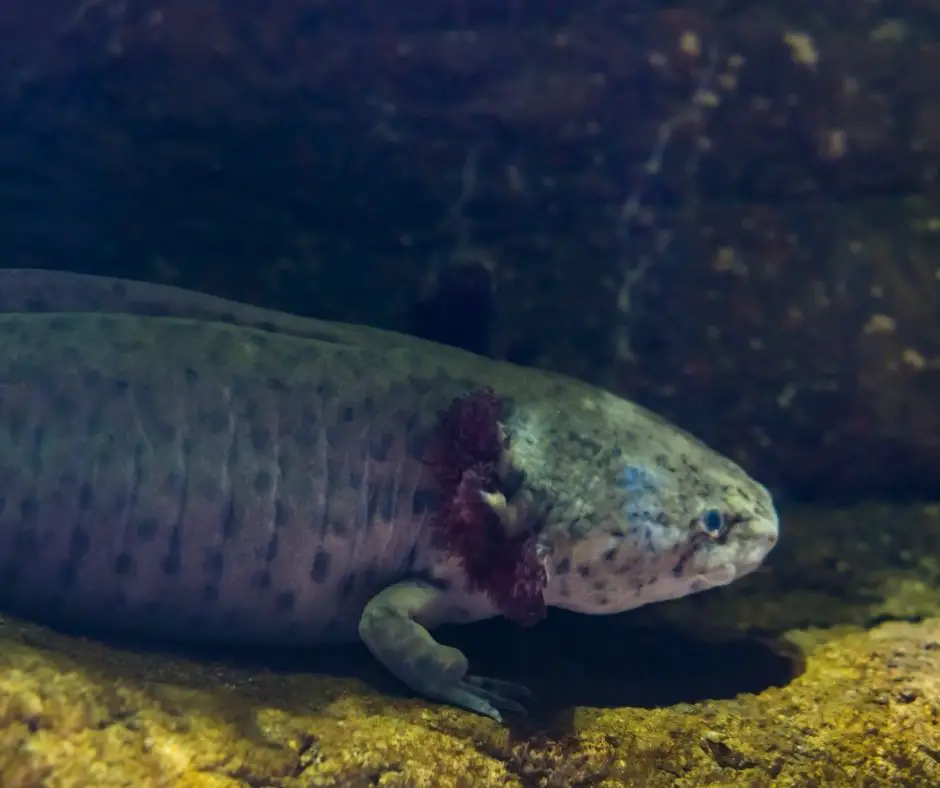
Bacterial Infection
Axolotls can get bacterial infections if housed in poor tank conditions. The bad thing is that bacterial infections can be fatal in axolotls if it is not detected and treated early.
Some of the bacterial infections that axolotls can have are stated below.
Columnaris
Columnaris is a bacterial infection that looks like a fungus if checked with our naked eyes.
However, it is a bacterial infection if checked under the microscope. columnaris is opportunistic in nature and usually infects stressed axolotls.
It can also infect older or weak axolotls. Some of the symptoms of columnaris in axolotls are:
- Loss of appetite
- Fluffy gray or white patches
- Lethargy
Although columnaris infection can be fatal if left untreated, you can easily treat it if detected early.
You can treat columnaris with antibiotics and salt baths. However, this can be tricky because columnaris looks like a fungus infection, and you are unsure what it is.
You can use MinnFinn to treat your axolotl, as this can be used to treat both fungus and columnaris.
A great way to prevent columnaris in axolotls is to ensure their environmental conditions are ideal, and you can quarantine new pets before adding them to a tank.
Neoplex 10 Gram by Seachem Laboratories
Septicemia
Septicemia is a fatal infection if the bacteria can penetrate the vital organ of your axolotls, and this health condition occurs when your axolotl is weakened by stress or other several things.
Some of the symptoms of septicemia in axolotls are:
- Loss of appetite
- Weight loss
- Redness and swelling of your axolotl’s limbs
- Abdominal bloating
- Ulcers or body sores
- Change in the neurological function of your axolotls
- Internal bleeding or hemorrhaging
It is important to treat septicemia infection as fast as possible for the treatment to be effective. Therefore, you will need to take your axolotl to the vet as soon as you detect the problem of antibiotics injection.
However, you can try to treat it using water-borne antibiotics like Furan 2, Kanaplex, etc., if your vet is not available.
A great way to prevent the outbreak of septicemia is to keep your axolotl’s immune system strong by providing them with ideal nutrition and suitable environmental conditions.
You should also try quarantining new axolotls before introducing them to a tank.
Seachem KanaPlex Fungal & Bacterial Fish Disease
Mycobacteriosis
Mycobacteriosis, popularly known as fish granuloma, is a bacterial infection that can affect axolotls. This infection causes small round granulomas to form in the tissue of your axolotl as they try to isolate and fight the infection.
Mycobacteriosis usually occurs in older or weaker axolotls that are stressed. Some of the symptoms of mycobacteriosis are:
- Change in the neurological function
- Your axolotl becomes bloated
- Red sores or ulcers on your axolotls
- Loss of appetite
Once you notice these signs, you will need a lab diagnosis to help ensure your axolotl is infected by mycobacteriosis, as the signs look like a septicemia infection.
There are no recognized treatments for this condition in axolotls, as you can only prevent it from happening. Some of the ways to prevent mycobacteriosis are:
- Feeding them a nutritious diet
- Reducing stress for your axolotls
- Keeping the water temperature at an optimal level
- Treatment with vitamin C to help boost your axolotl’s immune system.
Note: Some information suggests that mycobacteriosis can be transmitted to humans. Elderly or owners with open wounds are most vulnerable to this species.
Although there are no reliable sources for it, It is recommended to wear aquarium safe gloves to maintain their tank or interact with your axolotls.
SunGrow Rubber Aquarium Gloves
- More Effective Than Scrub Brush --- Using a long scrub brush to clean dirt from your aquarium may be suitable for quick work, but for a thorough process, it is best to put on some gloves and get in there yourself. SunGrow’s 2 Rubber Aquarium Gloves are perfect for reaching deep into your fish tank and wiping all the nooks and crannies of your underwater environment with a handheld scrubber.
- Keep Hands And Arms Dry --- At a length of 22” (56cm), the pair of SunGrow Aquarium Gloves keep your hands and arms dry when working in your fish tank. Depending on the size of the wearer, the rubber gloves reach above the elbow on most people, making it easy to roll up your sleeves and get to work. The waterproof latex ensures that no water seeps through and your hands remain dry during the entire process.
- Carefully Handle Sensitive Organisms --- Some aquatic organisms are highly sensitive to touch and don’t like to be moved around much. When working with live coral, anemone, life rock, and other delicate marine life, it is best to use rubber gloves like these from SunGrow. Wearing gloves will protect both you and your aquatic pets and plants.
- High Quality Latex Material --- Keeping durability and convenience in mind, the SunGrow Aquarium Gloves are constructed using only the highest quality rubber latex. This superior material is waterproof and will not leak. It is possible to poke holes in the rubber, so avoid anything sharp or pointy. The long-lasting pair of gloves can be used and reused for years when cared for and kept properly.
- Elastic Grip Band For Extra Security --- At the top of the long latex aquarium gloves is an elastic band that tightly yet gently grips onto your arm. The arm grip not only provides extra security by holding the glove in place, but it also restricts any stray splashes of water from getting in through the top of your glove.
Last update on 2022-12-29 / Affiliate links / Images from Amazon Product Advertising API
Parasites
Since axolotls are fed live foods, they are susceptible to parasite infections carried by live foods. There are several parasites that can affect your axolotls, and they are stated below:
Anchor worms or Lerneose (Lernaea)
Anchor worms are small parasites, usually white or red. The female anchor worms will cling to the gills and skin of your axolotl to feed after mating. Some of the symptoms of anchor worm in axolotls are:
- Loss of appetite
- Difficulty breathing
- Your axolotl scratches against the decorations in the tank.
The best way to treat anchor worms is to hold your axolotl with a wet tissue and remove the worms. You can then disinfect the area affected by the worm with betadine to help remove anchor worm eggs from the skin.
It is also important to quarantine the affected axolotl and change the water in the tank to remove the anchor worm eggs.
However, you can prevent this by checking and quarantining the live food before offering it to your axolotls.
Fritz Mardel – Coppersafe – 16oz
- Treats 376 gallons
- Not for use in reef aquariums
- For use in fresh and Saltwater tanks
- Live Nitrifying Bacteria eliminates Ammonia and Nitrates
Last update on 2022-12-29 / Affiliate links / Images from Amazon Product Advertising API
Anorexia And Intestinal Worms
Anorexia is a health condition where your axolotls start to lose weight until it dies. Anorexia in axolotl can occur if you feed your axolotl with unsuitable food or they have intestinal worms.
Intestinal worms will feed on what your axolotl ingested, leaving no nutrient for your axolotl to digest.
Poor tank maintenance can also cause anorexia because your axolotl can get stressed and may start to regurgitate their food. Some of the signs of anorexia are
- Your axolotl gets thinner
- Your axolotl has difficulty moving
- Your axolotl refuses to eat.
The best way to treat this health condition is to consult with your vet for diagnosis and treatment.
Hexamita (or Opalina)
Hexamita is an internal parasite that can affect your axolotls. Like most parasites, Hexamita is transmitted to axolotl from live food infected with the parasite.
You can confirm that your axolotl is infested with Hexamita by doing a microscope analysis of the fecal matter.
However, some of the signs that may indicate that your axolotl is infected by Hexamita are:
- Your axolotl remains skinny no matter how much you feed them.
- Your axolotl may have difficulty eating.
You can treat Hexamita in axolotl by adding Metronidazole into their food.
Seachem Metronidazole 5gram
- Treats bacterial infections
- For marine and freshwater use
- Easy to dose, easy to use. For ornamental fish only.
Last update on 2022-12-29 / Affiliate links / Images from Amazon Product Advertising API
Trichodina (or Costia)
Trichodina is a parasite that can affect your axolotl through contaminated fish, aquarium water, or plants. Trichodina cannot be seen with our naked eyes but from a microscope. Trichodina usually irritates the gills and skin of your axolotl.
You can detect if your axolotl is affected by this if there is excess slime on their body. You don’t really have to quarantine the affected axolotl, as everything in the tank would have been infested.
However, you can treat infected axolotl with a formalin bath or MinnFinn.
However, you can try preventing this condition by quarantining live foods and new inhabitants before introducing them to a tank. You should also ensure the water quality in your axolotl tank is at an optimal level.
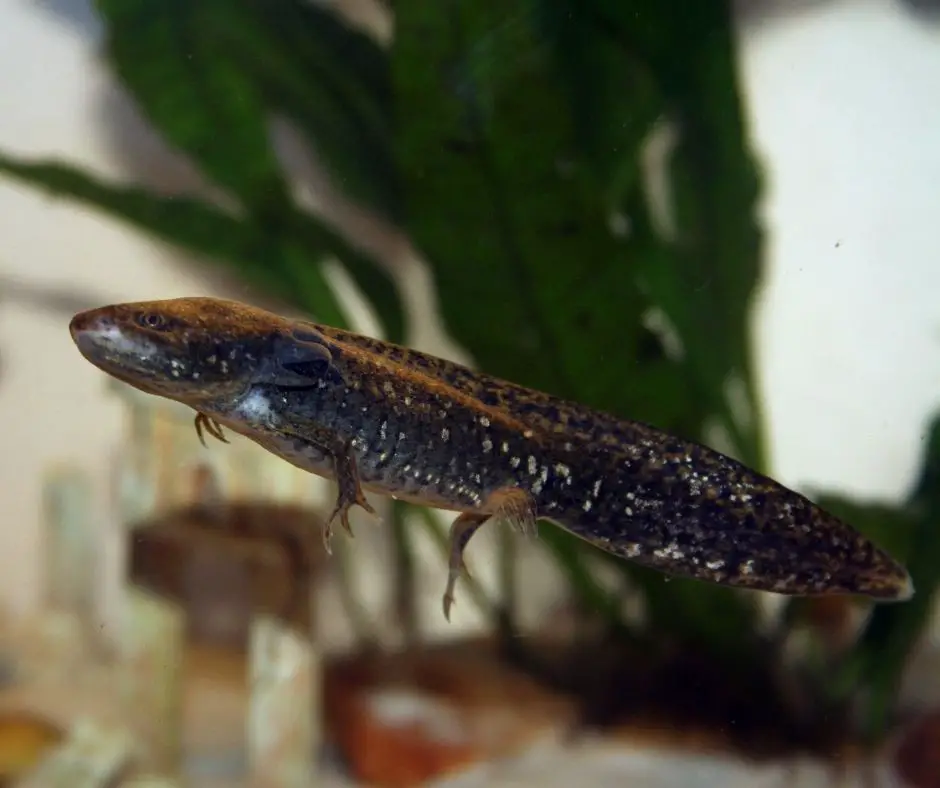
Myxobolus Cerebralis
Myxobolus, also called whirling disease, is an illness where the parasite affects the normal function of your axolotl’s brain, leading to loss of equilibrium. The good news is that this is not a common health problem for axolotls.
Myxobolus can infest your axolotls if fed with tubifex worms, a primary vector for its transmission.
Furthermore, it is also possible for this health problem to affect axolotls kept outdoors. Whirling disease is highly contagious, and you need to quarantine the affected fish to reduce its spread.
Some of the signs of whirling disease in axolotls are:
- Axolotl swims in a circle
- Loss of appetite
- Axolotl floats sideways or heads down
- Your axolotl has bent spine
Sadly, whirling disease is fatal to the affected animal, and you may need to euthanize your axolotl.
However, in rare cases, you can treat it using a combination of different antibiotics like metronidazole, Kanamycin, and Nitrofurazone.
Fungus
Fungus is among the most common health problems that affect axolotls. Some of the fungus infections that can affect axolotls are stated below.
Mycosis
Mycosis is a fungus that looks like cotton, and you can find it on the gills of your axolotls, or they form dark patches on their skin. Mycosis usually occurs because of bad maintenance of your axolotl’s tank.
You can treat this by changing the water in your axolotl’s tank and cleaning the decorations in the tank. The fungus will fall off in about 48 hours. However, you may need to consult with your vet if it is past 3 days and it has not fallen off.
Some of the ways to prevent the formation of mycosis on your axolotl are:
- Ensure you clean their tank regularly, and the water temperature is at an ideal level
- Use a good filter
- Always remove uneaten foods regularly before they decompose in the tank.
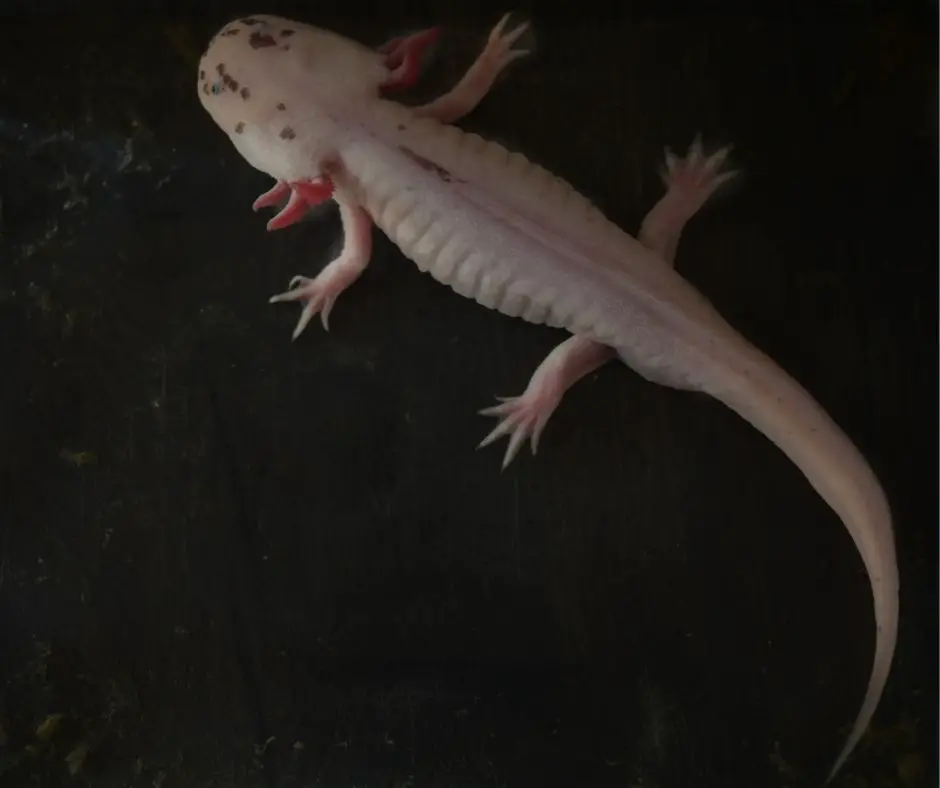
Saprolegnia
Saprolegnia is a common fungal infection that affects your axolotl, and it usually attacks your axolotl when they are stressed or weak.
Saprolegnia infection also occurs if the water parameter is not at an ideal level or there is an injury to a tank mate.
Some of the symptoms of Saprolegnia are
- Presence of white or gray patchy areas on your axolotls
- There is tissue necrosis on your axolotl
- Presence of fluffy white cottony tufts on your axolotls’ gills, limbs, or body.
Since Saprolegnia looks like columnaris, it is best to use a treatment that can treat both conditions. However, if a Saprolegnia infection in your axolotl is very severe, you may need to amputate the affected limb as advised by the vet.
You can prevent this health problem by maintaining the water quality in the tank and preventing aggressions between tank mates.
Ich
Axolotls can have ich, but it is not usually the same symptoms as other fish. Axolotls usually develop whiteness on their body when they have ich but will not start to swim upside down. However, axolotls can get ich from the fish they eat.
Ich infection will eat away your axolotl’s skin and can then cause harm to your axolotl’s body.
Therefore, you need to treat it when it notices it before it develops to the other part. You can first consult with your vet for the best way to treat this condition.
However, you can treat it with a salt bath treatment. You will also need to regularly change the water in your axolotl’s tank until the ich is gone.
Another thing is that ich develops faster in warmer water, and ensuring the water is slightly colder can help stop the infestation.
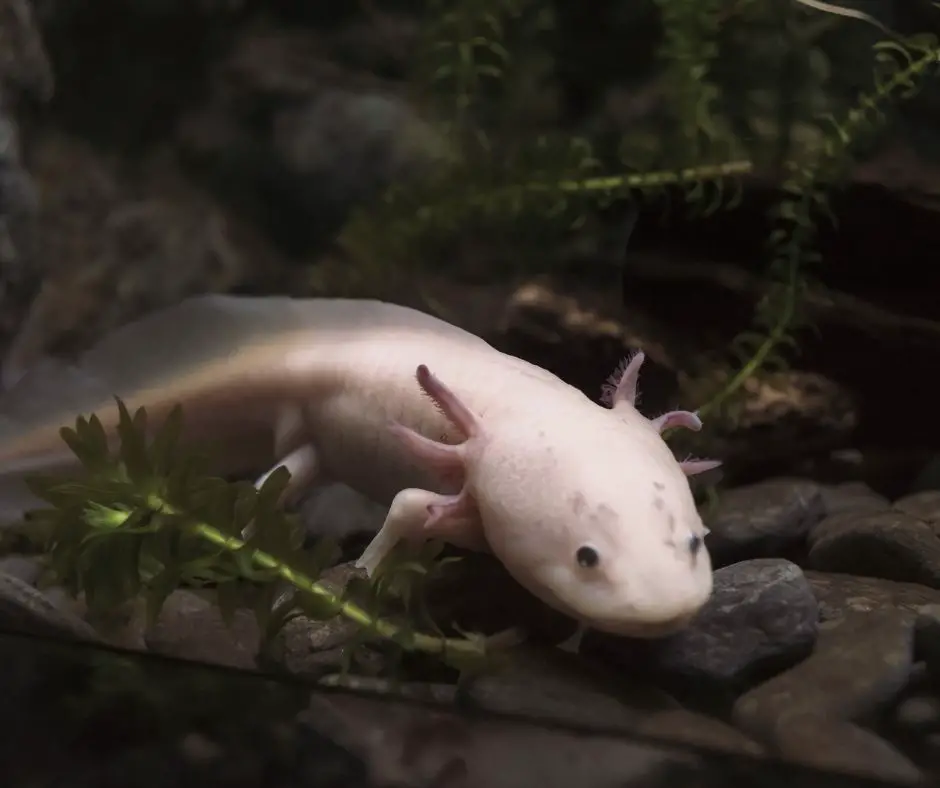
Toxicosis/Chemical Burns
Chemical burns are chemical wounds found on axolotl’s skin, fins, gills, and eyes due to the accumulation of ammonia and nitrite in the water.
Toxicosis can cause fatal external and internal bacterial infections to axolotls and can even cause sudden death if not addressed.
Some of the causes of chemical burns in axolotls are:
- Use of chlorinated tap water for housing your axolotls.
- Housing axolotls in a tank that is not fully cycled
- Housing axolotls in an overpopulated enclosure
- Housing axolotls in a small tank.
- Not maintaining your axolotl tank regularly.
Some of the symptoms of chemical burn in axolotls are:
- Ragged or frayed fins
- Cloudy eyes
- Presence of red blotches or streaks on your axolotls
A great way to treat this is to quarantine the affected fish and treat them with antibiotics. You will start to notice the signs of treatment 3-5 days after administering the treatment.
However, you should continue the treatment until your fish is eating normally before returning them to the tank.
You can then do a partial change of the water in the tank until the ammonia and nitrite level are back to normal. Test the water to help determine that the water parameter is at an ideal level.
You can prevent chemical burn in axolotl tank by following the tips below
- Invest in a good biological filter to help remove the chemicals from the water
- Do frequent water changes to help maintain good water quality.
- Test the aquarium water regularly to help notice any change in the water quality.
API FRESHWATER MASTER TEST KIT 800
- Contains one (1) API FRESHWATER MASTER TEST KIT 800-Test Freshwater Aquarium Water Master Test Kit, including 7 bottles of testing solutions, 1 color card and 4 glass tubes with cap
- Helps monitor water quality and prevent invisible water problems that can be harmful to fish and cause fish loss
- Accurately monitors 5 most vital water parameters levels in freshwater aquariums: pH, high range pH, ammonia, nitrite, nitrate
- Designed for use in freshwater aquariums only
- Use for weekly monitoring and when water or fish problems appear
Last update on 2022-12-30 / Affiliate links / Images from Amazon Product Advertising API
Organ Failure
Axolotls can experience organ failure due to genetics, disease, or diet. Some of the signs that an axolotl is suffering from organ failure are
- Loss of appetite
- Your axolotl becomes bloated
- Your axolotl develops bruise-looking patches on their cloaca or stomach.
There is no known treatment for organ failure in axolotls, and it is recommended that you euthanize the affected fish.
Abscess/Tumors
Although axolotls are resistant to cancer, they can get benign tumors. Benign tumors are unusual growth on the gills, head, or other parts of your axolotl’s body, usually caused by your axolotl’s pigment cells.
However, these growths don’t really affect the health of your axolotls, and a vet can help remove them if it is causing a problem for your axolotls.
Do Axolotls Carry Diseases to Humans
Yes, axolotls can transmit salmonella and mycobacteriosis to humans. This usually happens if a person with a weak immune system comes in contact with them.
Furthermore, it can pose a threat if you don’t wash your hands before and after handling your axolotls.
Salmonella infection in humans can cause pain, diarrhea, stomach cramps, or fever. However, it can be quite dangerous if a human with weak immunity gets salmonella poisoning.
You can easily avoid this by maintaining adequate water quality in your axolotl’s tanks. Furthermore, you should maintain personal hygiene whenever you handle or clean your axolotl’s tank.
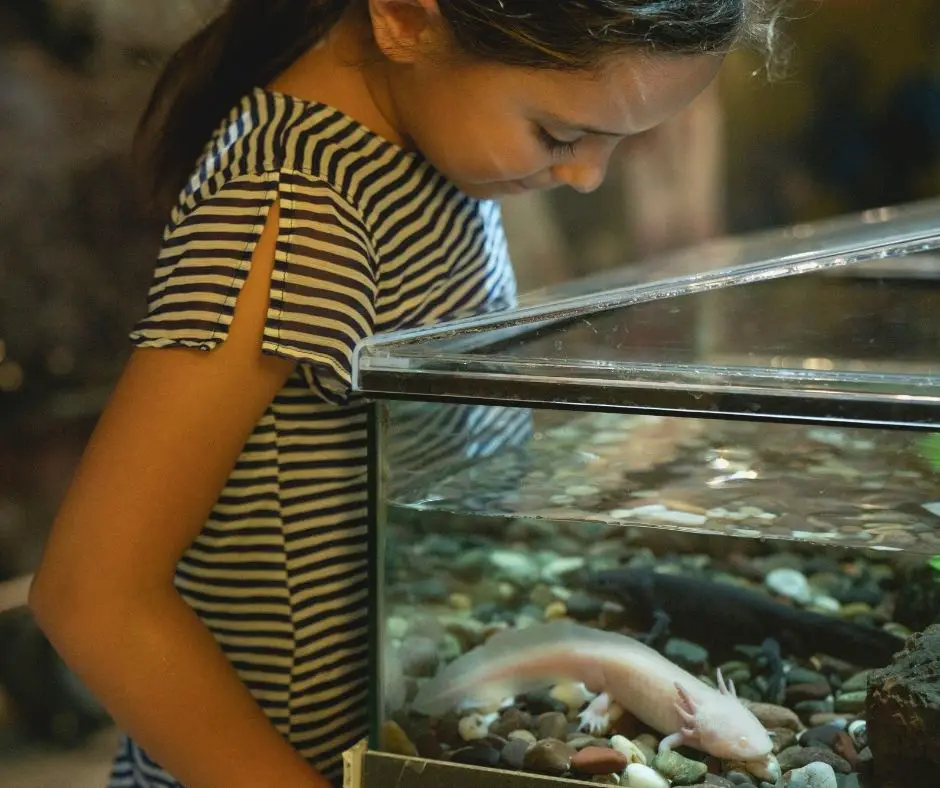
How Do You Treat a Sick Axolotl?
The first thing to do when treating a sick axolotl is to quarantine the sick axolotl to help prevent the spread of the disease. You can then determine the cause of the health issue.
After you have known your axolotl’s health concerns, you can then treat the specific cause of the health concerns at home or with your vet.
Tips to Prevent Diseases In Your Axolotl Aquarium
According to general sayings, prevention is better than cure. Therefore, you should take precautionary methods to help ensure your axolotls do not fall sick. Some of the ways to prevent disease in axolotls are stated below.
- Avoid overfeeding your axolotls, as this can cause constipation and increase waste production, leading to the buildup of ammonia in the water.
- Avoid feeding your axolotls with live foods from an unknown source as they can carry parasites.
- Only feed your axolotl with quality food from a known source.
- Avoid overcrowding axolotls in a tank as this can cause stress and injuries.
- Ensure you monitor the water parameters in your axolotl tank regularly.
- Ensure you change the water in your axolotl’s tank regularly.
- Avoid using chlorinated water when changing axolotl’s water.
- Ensure the water currents in your axolotl tank are not strong.
- Avoid using bright light for your axolotl’s tank.
- Monitor your axolotl for any change in behavior and signs of disease.
- Only handle your axolotls when needed.
Conclusion
We hope this article helps shed more light on the common diseases that can affect your axolotls. You will notice that most of the health problems to axolotls can be easily prevented by practicing good husbandry.
Once you notice any health problem in your axolotl, the first thing you can do is test the water parameter to determine what is happening. You can then consult with your vet if you are unsure what causes the problem.
